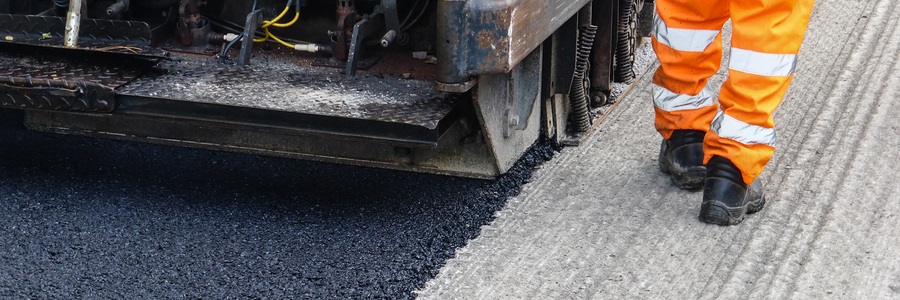9 Easy Facts About A1 Professional Asphalt & Sealing Llc Explained
9 Easy Facts About A1 Professional Asphalt & Sealing Llc Explained
Blog Article
The 4-Minute Rule for A1 Professional Asphalt & Sealing Llc
Table of ContentsA1 Professional Asphalt & Sealing Llc Things To Know Before You Get ThisAn Unbiased View of A1 Professional Asphalt & Sealing LlcNot known Details About A1 Professional Asphalt & Sealing Llc 4 Simple Techniques For A1 Professional Asphalt & Sealing LlcThe Best Strategy To Use For A1 Professional Asphalt & Sealing Llc

The oil in an auto engine is not just oil. The REOB includes all the additives that were in the waste oil as well as the wear steels from the engine (mainly iron and copper).
However, by making numerous blends making use of various REOB samples and different asphalt binders, the variants greatly can be balanced out. Numerous States offered samples of known REOB composition to TFHRC scientists, that examined the samples to compare the portion of included (recognized) REOB to the found (evaluated) quantity. The analyses showed a similar percent of added and located REOB.
Getting My A1 Professional Asphalt & Sealing Llc To Work
They got a frustrating response. The TFHRC researchers assessed 1,532 samples from 40 States, one Canadian province, and 2 Government Lands Highway divisions. They analyzed each example twiceamounting to greater than 3,000 analyses. None of those States recognized that the asphalt they were purchasing consisted of REOB. One State urged its examples had no REOB.
Of the 1,532 examples evaluated, 12 percent had REOB, and some had considerably high levels of it at 1020 percent. The highest degree was 34 percent in a sample from Texas, which TxDOT had made use of in a patching substance. This testing likewise revealed the visibility of phosphoric acid in 11 percent of the samples, and 2 percent contained ground tire rubber.
2 years ago at TRB's annual meeting, the Federal scientists held an REOB workshop and presented the findings of their research laboratory analyses to a standing room-only crowd. Although some agencies do not especially prohibit REOB, they do impose physical examinations that avert its useeffectively a ban. diagonal parking vs straight parking. Others do not ban it by spec, but have contracts with asphalt vendors to avoid making use of REOB
6 Easy Facts About A1 Professional Asphalt & Sealing Llc Explained
A handful do enable REOB, some within specific restrictions. Ohio and Texas restriction degrees to much less than 5 percent of the asphalt. To develop a reliable examination approach that all States can utilize, the TFHRC scientists set up a round-robin examination strategy. The individuals are 11 State highway firms (Illinois, Massachusetts, Minnesota, Mississippi, Montana, North Carolina, Oklahoma, South Carolina, Texas, Vermont, and Wyoming), 2 independent testing laboratories, the Ministry of Transportation in Ontario, Queen's University in Ontario, and an Ontario paving service provider.
In overall, the scientists prepared and shipped 720 blends. The participants are examining the examples individually utilizing the guidelines provided by the TFHRC researchers. The round-robin testing is nearly completed, and TFHRC remains in the process of collecting the results. The result will certainly be a recommended AASHTO examination technique that any State can take on and make use of (a1 asphalt).
The pavement with REOB, which is located 0.6 mile (1 kilometer) from the sidewalk without REOB, has identical subgrade, traffic thickness, and climate. The sector of Highway655 with 5 to 10 percent REOB revealed considerable breaking. In this instance, the visibility of REOB was the recognized root cause of splitting at a reduced temperature levels.
"In our experience in copyright, even tiny amounts of 23 percent can be a trouble." In a similar way, a section of examination sidewalk in Minnesota (MN1-4) discovered to include REOB likewise broke too soon. The sidewalk done well for the initial 3 to 4 years, but then began to break. This sidewalk is also subject to low temperature levels.
The Basic Principles Of A1 Professional Asphalt & Sealing Llc
The examinations were not considerable, but they revealed that at degrees of 6 percent or even more, the tensile toughness of the asphalt went down substantially. At a degree of 3.5 percent REOB, the variant in the physical test methods was higher than the impact of REOB. It was difficult for scientists to assess whether REOB was existing. https://medium.com/@a1asphaltsealng/about.

One binder specification taken into consideration is the distinction between the low temperature vital spec temperature for stiffness (S) in the bending beam rheometer and the flexing beam rheometer creep slope (m-value) noted as Tcritical. TC = TC (S) TC (m-value). Assessment of this criterion is still recurring. Two independent research teams, one from AASHTO and the other from the Asphalt Institute, concluded that more study is required on using REOB in asphalt.
Previously, all asphalt screening gauged design properties such as tightness. These examinations do not show what materials had been contributed to the asphalt. One example received throughout the TFHRC research had a really weird evaluation. The sample had the following test results: Superpave PG 64-28 with a high temperature level quality of 67.3 Tcritical on the Learn More bending light beam rheometer was 6.7 levels Celsius.

The Ultimate Guide To A1 Professional Asphalt & Sealing Llc
These results demonstrate there are weaknesses in the standard design screening procedures that may be exploited. The producer might have an economic benefit and the product passes all the standard tests, however the product might not be helpful to making certain long-term efficiency. To address this issue and the growth of new asphalt additives and extenders, TFHRC is starting a research program to use portable spectroscopic gadgets, x-ray fluorescence spectroscopy, and Fourier transform infrared spectroscopy to allow evaluations to be performed in the field instead of needing to take samples back to the laboratory.
Report this page